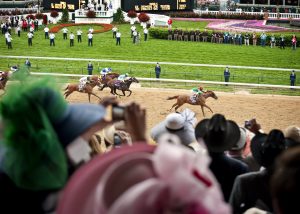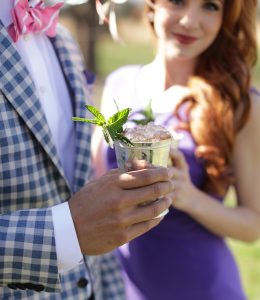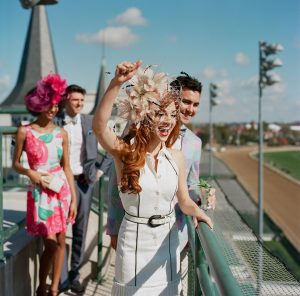Off to the Races
The Kentucky Derby celebrates 150 years
On May 4, thousands will gather at Louisville’s Churchill Downs for the 150th Kentucky Derby. And though the event’s excitement has earned it recognition as “the fastest two minutes in sports,” America’s premier horse race has a much longer history. “The Civil War devasted the breeding and racing industries, and Kentucky horsemen needed a new venue and prominent series of races to revive it,” says Chris Goodlett, Senior Director of Curatorial and Educational Affairs with The Kentucky Derby Museum. Meriwether Lewis Clark Jr. (grandson of William Clark, of American explorer team Lewis and Clark) was the person for the job. Though Clark had no previous racetrack experience, he had important family connections. These led to his introduction to thoroughbreds and acquisition of land—as well as a trip to England to study racing at just 26 years old. When these factors combined, a vision took form.

Photo: Kentucky Department of Tourism; Kentucky Derby Museum
In 1875, Clark and team opened Churchill Downs (then called The Louisville Jockey Club). Things looked a bit different than they do now: there were four races instead of 14, betting was done by auction pools instead of pari-mutuel wagering, and the race distance was 1.5 miles, a quarter mile longer than today’s. In the decades since, the Derby has continued to evolve in both stature and prestige, thanks much in part to businessman Matt Winn. The Louisville native attended the inaugural Kentucky Derby when he was just 14 years old and was instantly drawn to the sport, attending every one thereafter. Soon, he joined the Churchill Downs team to spearhead social events, launch pari-mutuel wagering, and arrange media opportunities to ensure ongoing success for the race and the grounds.
His efforts paid off—today, Churchill Downs welcomes more than 150,000 visitors to its gates each year, keeping the spectacle alive for more than a century. Traditions along the way have helped, too. From ice-cold concoctions to Hot Browns, here are a few of the event’s most prominent ones—and what kicked them off and has kept them going.
The Rose Garland
The winning Derby horse and jockey first received a wreath of roses and bouquet in 1896—but it wasn’t until several decades later that the iconic garland of roses became an official Derby tradition. In 1932, Louisville floral shop owner Grace Walker began making the masterpiece—a practice her daughter Betty Korfhage continued until 1984 when she sold the business. A few years later Kroger won the right to recreate it, now featuring more than 400 Freedom Roses (including one for each Derby starter, with a back lining featuring the Churchill logo on one end, and the seal of the Commonwealth of Kentucky on the other). The showpiece helped The Kentucky Derby to become known as the “Race for the Roses” thanks to sportswriter Bill Corum, who later became president of Churchill Downs in the 1950s.

Photo: Kentucky Department of Tourism; Kentucky Derby Museum
The Mint Julep
The mint julep—that Derby Day dram of bourbon, mint, and sugar—has a history longer than the Derby itself, dating back— some bourbon historians have determined— to the late 1700s and early 1800s. Many believe the cocktail made its debut at the track in 1875 and became a quick favorite—enough so that its loss was deeply felt during Prohibition times (as recorded in the Thoroughbred Record: “While the forty-fifth Kentucky Derby will long be remembered for many reasons, it will always be remembered as the last Derby when that most delectable of drinks, Kentucky’s own concoction, the famous Mint Julep, was available to take the sting from defeat and give edge to victory”). In 1938, Churchill Downs water glasses began disappearing from the dining areas, prompting management to charge an extra 25 cents for them and let guests keep them. Sales skyrocketed when the team began using them for mint juleps, and the glassware soon turned into a prized collector item. Since its 1938 inception, the Kentucky Derby Mint Julep Glass annual production has grown from less than 100,000 to today’s 700,000.

Photo: Kentucky Department of Tourism; Kentucky Derby Museum
Fashion
After witnessing the finesse and extravagance of European horse racing firsthand, Meriwether Lewis Clark Jr. was determined to bring a similar experience back to the States. Clark’s vision for track customs, alongside his wife Mary’s input, helped to draw both men and women to the then Louisville Jockey Club over the years. At the inaugural 1875 Derby, Mary and friends donned their finest and rode through town in open carriages, inviting socialites to attend—efforts that drew more than 10,000 of Louisville’s best-dressed guests. Hats became an even bigger part of the picture during the 1960s, when televised events encouraged spectators to further hone their fashion choices for a chance to meet the big screen.
Food and Drink
Pair up a julep with one of the track’s traditional Kentucky foods—burgoo, BBQ, country ham—or those that shine a light on the Louisville region, specifically: Benedictine, Derby Pie from Kern’s Kitchen, or a hot brown from the Brown Hotel, a beloved open-faced turkey sandwich with bacon and Mornay sauce. And then, there are the sweets—Rebecca Ruth Candy is a Kentucky staple that has garnered praise over the years for their bourbon-chocolate selection.
_
Berkley One is a Berkley Company.



